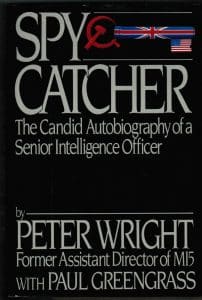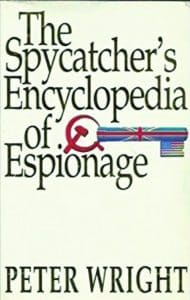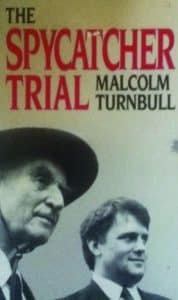One old spy’s secrets about Ireland
Peter wright CBE of MI5 finally managed to publish his highly controversial memoirs, ‘Spycatcher’, exactly 30 years ago this July. He did so after winning a volcanic legal battle in Australia against Her Majesty’s Government (HMG) which had tried to prevent its publication. ‘Spycatcher’ cast MI5 and MI6 in a deplorable light: little more than organisations riddled with traitors and immersed in criminality.
Throughout the trial, HMG was stretched on an anvil and hammered mercilessly by Wright’s dogged lawyer, Malcolm Turnbull, who is now the Prime Minister of Australia. when Turnbull published his own account of the affair, ‘The Spycatcher Trial’, he recounted how he had asked Wright at their first meeting if he thought HMG feared he might reveal other secrets. “They might”, Wright replied adding mysteriously: “I spent a lot of time in Northern Ireland, you know. But I won’t reveal anything about that. Malcolm, it would be easy for me to make this book very sensational indeed”.
Wright had also cautioned Turnbull that: “I may never be able to tell you the truth about some things”. When Turnbull asked him what he meant, Wright responded: “My work in Northern Ireland, for example. satellite surveillance. A lot of things. This is a safe book compared to what I could write”.
Threats, counter-threats, and a spy’s life-assurance policy
Wright had retired from MI5 in 1976 a disgruntled man. He and his wife Lois emigrated to Australia to live near one of their daughters, Jennifer, in Tasmania to raise horses. By the 1980s he had decided to put his pen into some ink.
Wright had diabetes, and was frail and generally in poor health. Before the Australian courtroom drama began, Turnbull visited London where he met a senior legal figure acting on behalf of HMG. Turnbull’s arm was seized by the lawyer and held in a “hard” grip. “Well you tell [Wright] from me”, the lawyer said “that he’d better seek some medical advice before he comes to court. He’ll get no quarter in the witness box on account of his ill-health”. While this was clearly not a death threat, if this was how the occupant of one of HMG’s loftiest legal perches was prepared to conduct himself, what was to be expected from the gangsters in MI5? Wright had participated in at least one – if not multiple – MI5 assassination operations and knew perfectly well what its cutthroats were capable of. It probably crossed his mind that given half the chance they might, for example, arrange a road-traffic accident along a dusty Tasmanian dirt track. To avoid this, he took out a life assurance policy, one that involved a threat to reveal his unpublished secrets if he was murdered.
The legal wrangling dragged on for another year. On 14 June 1988, while an injunction restraining British newspapers from publishing the contents of the book was crumbling in the House of Lords in London, Wright made his threat public: “There are 10 major stories which I have not put in [‘Spycatcher’] and there are probably others if I thought about it. I may put them into a secret report or I may do nothing. I just haven’t thought it out yet”. The next day, The Times reported that HMG had “always been aware that Mr Wright knew a lot more than he revealed in ‘Spycatcher’, particularly concerning his service as an MI5 officer in Northern Ireland”.
From his home in Australia, Wright buoyed the story by proclaiming that the real reason HMG had gone to such lengths to muzzle him was “because of the other things I know. But I said in the beginning I wouldn’t publish them and I haven’t done it. They have always been frightened of what I know…”. Just in case the message wasn’t clear, he told the BBC that his future course of action would depend on how HMG “behaved themselves”.
‘I spent a lot of time in Ireland, and it was not pleasant’
‘Spycatcher’ became an international bestseller shifting over two million copies and earned Wright a fortune. His ghostwriter, Paul Greengrass, went on to great success as a film director. His credits include the Jason Bourne film series.
After his publishing success, Wright retreated into virtual seclusion on his small farm near the apple-growing centre of Cygnet, at least for a while. Whereas he had once courted the media, requests for interviews were now batted out-of-court by his wife Lois. “Sorry. He won’t talk to journalists or anyone else like that”, she was quoted as saying. “He has nothing left to say”.
But he had plenty left to say, albeit that some of it was utterly innocuous. On 12 August 1990 the Sunday Times reported that he was writing another book provisionally entitled ‘Tomorrow Is Another Day’ about “a tamer topic that should unsettle no government”, the rearing of pedigree animals. But at least the proposed publication provided Wright with an opportunity to remind HMG to behave itself. “Peter does talk occasionally about writing down some post-‘Spycatcher’ reflections, but I fear they may never come to fruition”, Sandy Grant, the managing director of Heinemann in Australia, was quoted as saying.
In 1991 he published a second spy book but it was a limp offering, little more than an A-Z of espionage terminology with a few stories thrown in for good measure. It was entitled the ‘Spycatcher’s encyclopedia of espionage’. There was, however, a hint in it at the Irish secrets he intended to carry to his grave if HMG behaved itself. “I spent a lot of time in Ireland”, he intoned, “and it was not pleasant. We also did a lot of things there which I am never going to talk about, because it would just cause more trouble”.
There is a possibility, albeit a wafer-thin one, that Wright may have eventually let Turnbull have a peep inside his box of secrets. In his book, Turnbull was able to describe how Wright “had been privy to some of the weightiest secrets of the free world, he had spied on presidents and prime ministers, he was at the very centre of the fight against the…IRA)”. Perhaps one day Turnbull will clarify what – if anything – he learnt about Wright’s activities in Ireland and whether he knows anything about a secret dossier.
MI5’s peeping tom supreme
By the 1960s Wright had become MI5’s Witchfinder General, a position he exploited to accumulate mountains of dossiers containing embarrassing secrets about the British establishment. During the incessant mole hunts Wright undertook, he was granted access to any file he required in his search for treachery, real or imagined. His meddlings ranged across universities, government departments – especially the foreign and Commonwealth Office and Home Office – Buckingham Palace, and anywhere else that took his fancy. He even interviewed Airey Neave MP, who had escaped from Colditz, about the political leanings of his fellow non-British prisoners. According to Wright, MI5’s D-G, roger Hollis, instructed “that I myself had to conduct any interview deemed sensitive, which normally meant it was with a lord, a knight, politician, top civil servant, or spy suspect”.
One of those Wright interrogated was the arch MI5 traitor, Sir Anthony Blunt. Blunt was prepared to betray many of his friends to preserve his position: “Blunt, too, loved to discuss the scandalous side of Cambridge life in the 1930s…I soon realised that the [Cambridge] ring of five stood at the centre of a series of other connecting rings, each pledged to silence, each anxious to protect secrets from outsiders. There was the secret ring of homosexuals, where loyalty to their kind overrode all other obligations; there was the secret world of the Apostles [a group of Cambridge intellectuals], where ties to fellow Apostles remain strong throughout life; and then there was the ring of those friends of Blunt and [Guy] Burgess who were not themselves spies, but who knew or guessed what was going on. each ring supported the others, and made the task of identifying the inner core that much more difficult”.4
“I had seen into the secret heart of the present establishment at a time when they had been young and careless. I knew their scandals and their intrigues. I knew too much, and they knew it”.
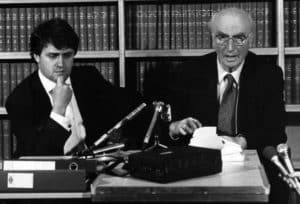
Nothing has changed
Wright personally interviewed and re-interviewed more than 100 people over a period of six years. By the end of it he could boast: “I had seen into the secret heart of the present establishment at a time when they had been young and careless. I knew their scandals and their intrigues. I knew too much, and they knew it”. One of these was the former PM Anthony Eden. All of this gave MI5 a power over the political establishment and provides one clue – among many – as to why successive governments have mangled their reputations by covering up the criminal activities of MI5.
The control of politicians by the darker elements of the civil service has not changed much in the intervening decades. David Cameron told the family of Patrick Finucane (the Belfast solicitor who had been assassinated by British agents in NI) that he could not order a public inquiry into the scandal. Finucane’s brother Martin asked him why. In a moment of candour Cameron turned to Mrs. Finucane and said: “look, the last administration couldn’t deliver an inquiry in your husband’s case and neither can we”. According to Cameron this was because “there are people all around this place, [10 Downing street], who won’t let it happen”. As he was saying this, he raised a finger and made a circular motion in the air.
What gave those ‘around’ Cameron such sway over his administration – not to mention that of Tony Blair and Gordon Brown? Theresa May was Home secretary at the time so there is no reason to suspect that anything has changed since she became PM.

Formulating MI5’s policy for Ireland
By the early 1970s, Wright had clawed his way to the top of MI5’s greasy, bloodstained pole. He was close to its D-G, Sir Martin Furnival Jones. When Michael Hanley, the Deputy D-G of MI5 became D-G in 1972, he appointed Wright as his special adviser. Hanley asked Wright to formulate proposals about how MI5 should deal with NI after which he spent “a lot of time in Ireland” and did the mysterious things which would have caused “more trouble” if they were ever exposed. The Irish Times, Irish Independent and other mainstream publications never lifted a finger to follow up the tempting clues the old curmudgeon had laid out so publicly.
Nerve gas and poison
What Wright divulged in ‘Spycatcher’ was hair-raising enough. He described how he and an Irishman called Bill Magan had plotted to ‘neutralise’ General Grivas during Britain’s struggle against EOKA in Cyprus in the late 1950s; a treasonous plot against PM Harold Wilson; and wrongdoing by MI5’s blood brothers over at MI6. He described how at the start of the Suez Crisis, MI6 had “developed a plan, through the London station, to
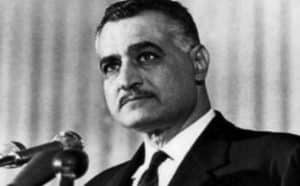
assassinate [Egypt’s President] Nasser using nerve gas. [British PM Anthony] Eden initially gave his approval to the operation, but later rescinded it when he got agreement from the French and Israelis to engage in joint military action. When this course failed, and he was forced to withdraw [from Suez], Eden reactivated the assassination option a second time. By this time virtually all MI6 assets in Egypt had been rounded up by Nasser, and a new operation, using renegade Egyptian officers, was drawn up, but it failed lamentably, principally because the cache of weapons which had been hidden on the outskirts of Cairo was found to be defective”.
Had the nerve-gas plot proceeded, the collateral damage to Nasser’s secretarial and domestic staff, not to mention anyone happening to visit him, would have been devastating. The gas would have asphyxiated the victims while melting their vital organs. The gas MI6 had in mind to assassinate Nasser was undoubtedly developed by HMG’s team of Dr. Strangeloves at a ghoulish scientific complex known as Porton Down. Wright described how he once visited it for a demonstration of a cigarette packet which had been fitted with a poison tipped dart by the staff of the explosives Research and Development Establishment: “we solemnly put on white coats and were taken out to one of the animal compounds behind Porton by Dr. Ladell, the scientist there who handled all MI5 and MI6 work. A sheep on a lead was led into the centre of the ring. One flank had been shaved to reveal the coarse pink skin. Ladell’s assistant pulled out the cigarette packet and stepped forward. The sheep started, and was restrained by the lead, and I thought perhaps the device had misfired. But then the sheep’s knees began to buckle, and it started rolling its eyes and frothing at the mouth. Slowly the animal sank to the ground, life draining away, as the white-coated professionals discussed the advantages of the modern new toxin around the corpse”.
Porton Down is still open for business.
Secret #1
Peeping at the Royal Family’s dirty linen (1945)
Peter Wright died a rich yet bitter man in 1995 at the age of 78. He had spent his declining years referring to Thatcher as a “bitch” and those around her as “those bastards”. Assuming he compiled a secret dossier, what happened to it? After the passage of three decades it is unlikely it will now surface. Instead Village will take a stab at what it might have contained. A sobering thought is that for every error we may make, the likelihood is that some other unreported horror story remains concealed. Before Wright’s began his interrogation of Blunt, he received a briefing from Michael Adeane, the Queen’s Private secretary, who told him: “from time to time you may find Blunt referring to an assignment he undertook on behalf of the Palace – a visit to Germany at the end of the war. Please do not pursue this matter. strictly speaking, it is not relevant to considerations of national security” (‘spycatcher’ p223). Wright was hardly going to deny MI5 an insight into this mystery since Blunt had undoubtedly passed details of it to his KGB handlers. The odds are high he learnt that Blunt had been sent to Germany to recover the correspondence the Duke of windsor had exchanged with the Nazi hierarchy after his abdication. revelation of this nature, even in 1987, still had the potential to shake the foundations of Buckingham Palace.
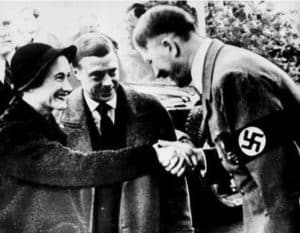
SECRET #2
Bombing ships carrying Holocaust survivors (1946-47)
Last April Village described how in 1946 and 1947 MI6 ran an operation to disrupt the flow of Jewish refugees from Mediterranean ports to Palestine, codenamed Operation Embarrass. One of the MI6 unit was an Irishman, wing-Commander Derek Verschoyle. The first account of the Operation emerged in ‘The Friends’, a book about MI6 published by Nigel West in 1988, a year after ‘Spycatcher’. MI6 expert Dr. Stephen Dorrill dug up additional details which he published in 2000 revealing how one former MI6 officer had described it as the “blackest page in MI6’s postwar history” and that there had been persistent rumours that one unidentified ship packed with Holocaust survivors “may have been blown up at sea, whether by accident or design”. MI6 acknowledged the existence of the operation in 2010 when it let Professor Keith Jeffery of Queens University, Belfast, include an account of it in the official history of MI6 it had asked him to write. In fairness to MI6, it should be commended for the disclosure. It shows that not everyone in it is addicted to lies, deceit and cover-up and offers a glimmer of hope that it may be mending some of its ways. Any reformers should note too that MI6 survived the revelation without much condemnation. Time now to admit the Dublin bombings of 1972, perhaps?
SECRET #3
The sexual blackmail of an archbishop (1959-60)
Bizarrely, while Wright was prepared to admit that he had been involved in a plot to kill Colonel Grivas in Cyprus, he was coy about the sexual blackmail of the Colonel’s political ally, Archbishop Makarios. That operation was also exposed by Nigel West in 1988. Two years later no less a figure than Sir Dick White, the former head of both MI5 and MI6, confirmed that it had occurred. Wright and a colleague from MI6 had placed a listening device on the telephone lines leading to the Archbishop’s Palace in Cyprus. MI6 also had a number of agents inside it controlled by Sir Stephen Hastings MC, who later became a Conservative MP. Wright gave no hint that any of them had discovered that the Archbishop was engaged in homosexual relations, or that this information had been used to blackmail him. If he had, the revelation might have raised questions about Wright’s involvement in the sexual blackmail of MI5 targets in Ireland, where the British Army and MI5 had established brothels for adult heterosexuals, not to mention the blackmail of members of the Anglo-Irish paedophile vice ring which preyed on boys at Kincora and elsewhere, some of them as young as eight years of age. Wright hardly relished the thought that his daughters would discover that their beloved father had stood back while children were raped and driven to suicide so that MI5 could blackmail some of the participants in a wide range of paedophile rings.
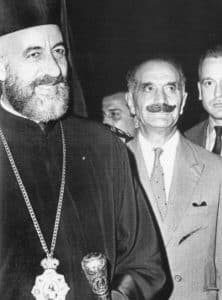
SECRET #4
The gruesome murder of Patrice Lumumba (1961)
Declassified CIA records confirm that President Eisenhower of the USA ordered the murder of Patrice Lumumba, PM of the Congo. Lumumba was killed in a joint CIA-MI6 operation in 1961. He had to endure a gruesome orgy of torture and violence that lasted for five or six hours before he finally expired. A harrowing account of it appears in the towering international bestseller, ‘The Devil’s Chessboard’ (2016), a biography of the egregiously evil Allen Dulles of the CIA. While the book focusses on the CIA’s involvement, MI6 played a significant part in it too, something Wright would have known about.
Howard Frank Trayton Smith, who served as Britain’s intelligence supremo in Northern Ireland, 1971-1972, was a pivotal figure in the murder. He later became Ambassador to Moscow and, in 1979, D-G of MI5. In 1960 Smith was a senior official at the Foreign Office with responsibility for the Congo. Daphne Park was serving as the MI6 Head of Station in the Congo. Park reported to Smith that Lumumba was allegedly trying to take his country into the Soviet camp. This was utter nonsense. Nonetheless, on 28 September, 1960, Smith circulated a memo to the Foreign Office where it was digested by a number of highly-placed powerbrokers including the future Prime Minister Ted Heath who was then a junior minister there. In it Smith nonchalantly explained he could see “only two possible solutions” to the situation: ‘The first is the simple one of ensuring Lumumba’s removal from the scene by killing him. This should in fact solve the problem, since so far as we can tell, Lumumba is not a leader of a movement within which there are potential successors of his quality and influence. His supporters are much less dangerous material”.
By the time Wright’s book was meandering towards the printing presses, Smith was a decorated and recently retired D-G of MI5: exactly the type of person HMG would instinctively rally to protect. Meanwhile, Daphne Park was deeply immersed in MI6’s Anglo-Irish machinations. she was a governor of the BBC (where she interfered with broadcasts about NI) and on the cusp of becoming a life peer. She was also a friend of the then serving Taoiseach Garret FitzGerald (through her management role in the BritishIrish Association). MI6 could not afford to allow Wright to expose her part in Lumumba’s murder or other aspects of her sordid past: in the 1970s she had served as the Head of MI6’s Western Hemisphere division where – at a minimum – she had knowledge of the MI6-CIA Gladio death squads active in Europe at the time and had spread smears about Charles Haughey across the globe through MI6-CIA-controlled news agencies. Had she been exposed by Wright, a veritable can of Irish worms might have wriggled free just as Haughey was about to wrest power back from FitzGerald, and HMG was fearful about what he might do with the Hillsborough Agreement and security co-operation generally. Incidentally, Park remained an unapologetic colonialist. When she was interviewed by the Daily Telegraph in April 2003 she stated that the “The [British] Government is too worried about speaking out [against Mugabe] because they think they will be accused of being colonialist. Well I don’t think that’s such a terrible crime”. Before her death, Park also acknowledged that: “Yes, I have been involved in death, but I cannot speak about that”. Interested readers should purchase a copy of the fascinating ‘Queen of Spies’ (2015) by the Dublin writer and intelligence expert, Paddy Hayes. One of the more interesting quotes in it is that of John de St Jorre of MI6 who worked with Park in Leopoldville: “I always thought of Daphne as a blend of Margaret Rutherford, the bosomy and beloved actress, and Rosa Klebb, the cold-eyed KGB dragon-lady with a poisonous blade in her shoe”.
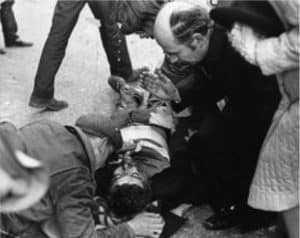
SECRET #5
MI5’s role in Bloody Sunday (JANUARY 1972)
In January 1972 British paratroopers shot dead 13 unarmed civilians in Derry. HMG responded by building a pyramid of lies around the truth. A tribunal manipulated by Lord Widgery did the necessary. His fraudulent report was published in 1972, exculpating the paratroopers. Aside from a few gullible Colonel Blimps in the shires, no one believed a word of it. Decades later the Saville Inquiry managed to shine a light over much of the truth but was deflected by counterinsurgency guru, Brigadier Frank Kitson, and MI5, from the scandal’s deeper secrets. As someone who was responsible for the formulation of MI5’s NI policy in 1972, Wright cannot but have known all there was to know about Kitson and MI5’s role in Bloody Sunday. At the time of the ‘Spycatcher’ affair, Kitson was a doyen of the British establishment having retired as Commander-in-Chief of the United Kingdom land forces just two years previously.
Kitson is now 90 years of age. On 27 April 2015 he and the Ministry of Defence were served with papers for negligence and misfeasance in office by Mary Heenan, widow of Eugene Heenan, a fifty-year-old Catholic with five children who was murdered in 1973 by members of the UDA led by a British agent called Albert ‘Ginger’ Baker, because of “the use of loyalist paramilitary gangs to contain the republican-nationalist threat through terror, manipulation of the rule of law, infiltration and subversion all core to the Kitson military of doctrine endorsed by the British Army and the British government at the time”.
SECRET #6
Bombing the Republic (1972)
The republic of Ireland was virgin territory and a playground for the dirty tricksters of MI5 and MI6 in 1972. In December of that year they organised two car bombings in Dublin while the Offences Against the State Bill was limping towards its doom inside Leinster House. Many of the deputies in the Dáil who were opposed to the bill backed off after the explosions and it was ushered on to the statute books. The assumption at the time was that the bombs were the work of militant republicans, especially as there were protests in the city that night against the arrest of the Chief of Staff of the Provisional IRA, Seán MacStíofáin. Last December Village published an analysis of the atrocity. It highlighted the probable complicity of Kitson’s Military Reaction Force (MRF) in it. Moreover, in April, we reported how a former MI6 trainee had learnt that MI6 had been involved in the 1972 attack and that it had garnered a legendary status inside MI6. As the man formulating MI5’s policy on Ireland, it is inconceivable that Peter Wright did not know everything there was to know about the MRF and the 1972 Dublin bombings. If, as suspected, MI6 and the MRF was behind it, it would surely rank as one of Wright’s unpublished secrets.
In addition, he would have known the inside story of the Littlejohn affair during which the Littlejohn brothers petrol-bombed Garda stations in 1972 at the behest of MI6. The Littlejohns were caught and imprisoned in Mountjoy for a bank heist they executed on Grafton street in October 1972. They were released from prison early by Garret FitzGerald in 1981 on “humanitarian” grounds and are still alive.
Joseph De Búrca
